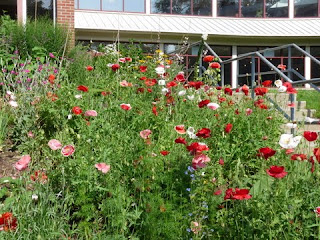
Monsonia burkeana, I think, is this nice white flowered species I saw in the Magaliesberg mountains north of Pretoria in 1993. I wandered around on a farm where all kinds of neat things could be found among the rocks, more of which I will share later. Even avid gardeners generally have never heard of monsonias, though they are close relations of the much more popular genera Geranium and Pelargonium. Some are annuals with a weedy look, but others are perennials which produce flowers all summer long, like this one and the similar M. emarginata, which is occasionally available from South African seed sources. Monsonias make huge interesting seeds with a coiled structure that unwinds when wet, allowing the sharply pointed seed to dig its way into the soil. Some also have fragrant leaves as is common in Pelargoniums. The most outstanding species is Monsonia speciosa, easily grown if you live in a mediterranean climate or have a cool greenhouse, but more of a challenge to those of us who don't. It has spectacular pink veined flowers which resemble a giant dianthus. It can be grown from seed, and plants can be propagated from root cuttings as well.
















































